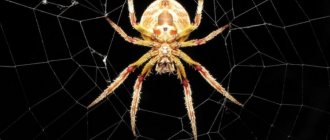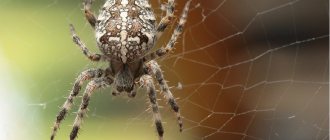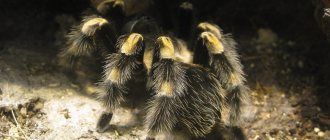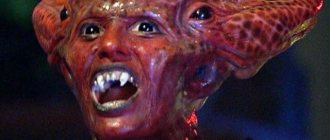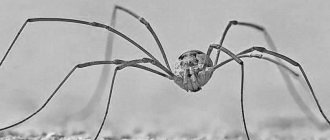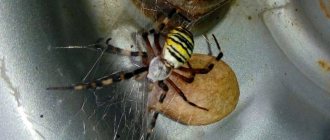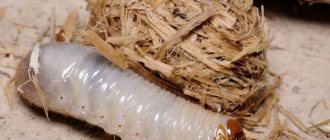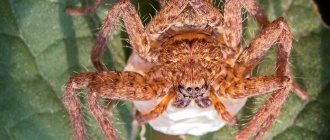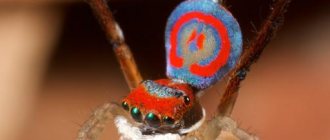Several residents of Sochi posted messages on social networks about huge spiders entering their homes. According to the Yugopolis portal, photographs of local residents show that the abdomen of such spiders is “the size of a walnut,” and the legs “reach five to seven centimeters.” As it turned out, the insects belong to the family of araneomorph spiders, they are also called pseudotarantulas or wolf spiders.
Arachnologists associate the penetration of spiders into residential buildings with warm weather conditions this year. Candidate of Biological Sciences, senior researcher at the Southern Scientific Center of the Russian Academy of Sciences (SSC RAS), arachnologist Alexander Ponomarev believes that wolf spiders could crawl into people’s homes due to the mating period that had begun.
“This year’s autumn turned out to be very warm and protracted, and perhaps the spiders’ breeding season has begun. In search of a partner, spiders can run into houses, since their numbers are high. This is the only explanation. They will not spend the winter in houses. Wolf spiders live in places with high levels of humidity, usually in forest areas located near water bodies,” Ponomarev told AiF.ru.
Hogna radiate. Photo: Commons.wikimedia.org
Karakurt
Poisonous spiders of the Krasnodar Territory live in arid places, live in burrows underground, and do not build trapping nets. They behave without aggression towards humans, but they can bite in defense of their own life. Most attacks by karakurts occur due to negligence, when a person does not notice the predator in shoes, things, or in a clearing.
After a spider bite, pain, swelling, redness, and swelling appear. After 15 minutes, general health worsens - nausea, vomiting, abdominal pain, head pain, tremors, muscle spasms, difficulty breathing, increased blood pressure, increased heart rate. If medical assistance is not provided, cardiac arrest occurs or the person dies from suffocation.
On a note!
The appearance of karakurt is memorable. The size of the female, together with the leg span, reaches 2 cm, the males are smaller. The most active young individuals. Legs, cephalothorax are black, red spots on the abdomen - 13 pieces. As they grow older, the color changes and becomes more uniform.
Karakurt and tarantula
What insects live in Kuban
The Krasnodar region is rich in fauna. Many different insects live there. Some representatives are dangerous. The table shows the main individuals.
| Narynivnik | It's a bug that bites. The bite site begins to swell. A large blister appears. The insect has a rich color. This informs other fauna that it is toxic and potentially dangerous. You have to be careful. An animal or child who eats a beetle can die instantly. It will be practically impossible to prevent death. There are dark spots on the body. In appearance, the representative vaguely resembles a ladybug. |
| Scolopendra ringed | Large creature. The centipede has a poisonous jaw. The representative prefers dark and humid places. The insect is poisonous. The bite site swells. Lymph nodes swell. The body length is 15 cm. The poison affects the composition of the blood. Pain at the site of the bite persists for several days. The insect often settles in human dwellings. |
These are the main poisonous representatives of the Krasnodar region.
South Russian tarantula
Dangerous spiders in Krasnodar live in dry places and build holes underground. The depth of the labyrinths of South Russian tarantulas reaches 40 cm. The entrance is protected by cobwebs. They feed on insects and their larvae. They hunt without leaving their own shelter.
On a note!
The South Russian tarantula is the largest spider in the Krasnodar region. The body is covered with thick hairs, the legs are long and powerful. Colors are gray, brown, white, ash. It differs from other tarantulas by its dark head. The body size of the female, together with the leg span, reaches 35 cm.
The bite is poisonous, but not fatal. Painful sensations are present for several days, the skin recovers in 2 weeks. People prone to allergies experience a deterioration in their health - nausea, weakness, dizziness, headache.
Giant flying cockroaches appeared in Sochi
American cockroaches have been spotted in urban areas of Sochi, reports
Sochi National Park. According to the source, the appearance of representatives of one of the largest cockroach species is associated with both unintentional importation and escape from terrariums. Regardless of origin, the new inhabitant has every chance of gaining a foothold on the Black Sea coast, experts say.
The American cockroach is often kept in terrariums as an exotic large insect, and also as a food supply for terrarium animals - lizards and certain species of snakes.
It comes from tropical areas of Africa. In 1625, it moved to North America, which led to the erroneous scientific name of the species, and then to Europe. The body length of an adult can reach 5 cm without whiskers. It has a red-brown color and can fly.
“Currently, this insect is found all over the world, inhabiting buildings exclusively in cold latitudes, and in warm areas, such as in Sochi, it lives both in buildings and in the natural environment, hiding during the day in various damp dark shelters, preferring rotting wood,” notes the SNP material.
In addition, American cockroaches reproduce quite actively - females lay from 15 to 90 oothecae during their lives, each of which contains from 14 to 16 eggs. At the peak of the reproductive period, within a week after mating, females develop two oothecae.
American cockroaches feed on almost any organic matter.
These insects are considered dangerous pests because they carry infections and can cause allergies in humans. In addition, they spoil food and materials in the structures in which they live. In Vietnam, American cockroaches are eaten fried, and in China, medicinal preparations are prepared from them.
was flooded due to the heat
poisonous karakurt spiders. The main habitats of karakurts are virgin wormwood, wastelands, and ravine slopes. In Russia they are found mainly in the south, but in the last decade the number of karakurts in the Rostov region has increased, they have appeared in the Altai Territory and the Novosibirsk region. In 2010, they were also discovered in the Volgograd and Saratov regions.
Karakurt does not attack animals or humans unless disturbed. The bite acts immediately - a burning pain appears, spreading throughout the body within 10-15 minutes. The victims complain of unbearable pain in the abdomen, lower back, and chest. The abdominal muscles tighten sharply. Other symptoms include shortness of breath, increased heart rate, dizziness, headache, trembling, vomiting, pale or flushed face, sweating, and a feeling of heaviness in the chest.
Deaths have been reported in humans and farm animals.
Antikarakurt serum is used for treatment; intravenous administration of novocaine, calcium chloride and magnesium hydrogen sulfate also gives good results.
The Moscow region is not suitable for karakurt habitat, experts note. They could have been brought here by the wind or they got into boxes with vegetables and fruits from hot regions.
Meanwhile Finland is at war
with rose hips.
The plant appeared in Finland in the 90s of the 20th century and quickly became widespread. So widespread that it has now had to be recognized as a harmful invasive species that threatens biological diversity. The government explained that if it is planted on the seashore, which is often done in Finland, it quickly spreads and replaces all the vegetation typical for that area.
Authorities have been calling for the destruction of rose hips in gardens, parks, beaches and roadsides for three years. Where the situation requires it, it is assumed that special equipment will be used. A ban has also been introduced on the import and sale of rose hips.
Sak
It also has other names - yellow, heyracantium. Poisonous spiders of the Kuban and Krasnodar Territory live in arid places and build burrows in the ground. They hunt actively at night. They run quickly, attack a victim several times larger in size, and win.
On a note!
The predator has a bright, memorable appearance. Legs, abdomen are yellow, cephalothorax is red, chelicerae are in the form of claws. Outwardly it looks more like a scorpion. The photo is presented below. The female is 1 cm in size, the males are 0.5 mm.
The spider is not aggressive towards humans, but it can bite in defense of its own life. At the site of the attack, an allergic reaction appears in the form of redness, swelling, and swelling. In young children and people prone to allergies, their health worsens. The condition returns to normal within a few days, the skin recovers within a week.
Spiders of the Krasnodar region
Are pseudotarantulas dangerous for humans?
These spiders are not dangerous to humans. On the Internet you can see many videos in which, upon contact with a person, a wolf spider runs away and does not attack. Wolf spiders are calm predators, but if they are continuously disturbed, they can bite.
“There is one species in Sochi, Hogna radiate lives there. This type of arthropod is not at all prone to attacking warm-blooded animals or people. In principle, it can bite through the skin, but there will be no serious, negative consequences,” says Ponomarev.
A spider bite may only cause itching, redness, or short-term pain.
Wolf spider
The largest spiders of Kuban. A relative of the karakurt, but not so poisonous. The bite provokes a local allergic reaction and rarely causes deterioration in health. The color is ashen, brown. The body is covered with dense villi. Females reach sizes of 4 cm, males are half that size.
The wolf spider does not weave hunting nets; it hunts actively. The victims are insects, their larvae, amphibians, and small rodents. In search of prey, it explores new territories and creeps into human possessions. In the house, it doesn’t reveal its presence in any way; it hides in corners, behind furniture, cabinets with dishes, shoes, and things.
How to repel tarantulas: the most effective methods
Wolf spiders are ground hunters that hide in the shadows or dark corners during the daytime. Therefore, they can suddenly attack a person at home or in the garden. The following methods will help scare off unwanted arthropod “neighbors”:
- Clean up your garden by removing grass clippings, leaves and firewood. Get rid of empty pots, rocks and grills that can provide hiding places for spiders;
- remove plants around the perimeter of the house, replant shrubs and other above-ground plants;
- Seal cracks and holes in the outside of the wall to reduce the risk of spiders getting inside;
- Install insect screens on all ventilation openings;
- remove outdoor lighting lamps, as a large number of flies, moths and other insects that wolf spiders feed on accumulate around the lamps.
Don't forget about the internal environment:
- Vacuuming your home regularly will help remove crumbs that may attract spiders and other insects. Remove any cobwebs you see;
- throw away cardboard boxes; it is better to use plastic containers instead;
- Get rid of clutter: throw away piles of old magazines, dirty clothes, books and boxes.
Chemical treatment also plays an important role:
- use specially designed anti-spider products. For this method to be effective, it must be combined with other methods;
- Wolf spiders are best repelled by residual pesticides scattered on the ground;
- use insecticides that contain pyrothroids, deltametry, cynometry, lambda-cyhalothrin, or bifenthrin, they are most effective against wolf spiders;
- Sprinkle boric acid around the house, paying special attention to dark corners, cracks and areas under furniture.
If your home or property is infested with wolf spiders, it is best to seek the help of specially trained and licensed professionals to use more powerful chemicals.
Poisonous spiders of Russia
In residential premises there are quite often cobwebs, the proximity of whose owners poses absolutely no threat to humans. But in some regions, the inhabitants of dark corners may be the poisonous spiders of Russia (Figure 1).
Figure 1. Main poisonous species: 1 - cross, 2 - chiracantida, 3 - black widow, 4 - tarantula
Direct contact with them should be avoided; if necessary, contact a specialist. The consequences of bites can seriously affect health, since the poisonous substances in their saliva contain infection or toxic proteins. But how can you determine who bit you and whether it is truly poisonous?
To do this, you should know for sure what photos and types of poisonous spiders in Russia look like:
- Cross spiders
- live in the central regions - pine and spruce, beech forests, in thickets near swamps, usually hang upside down in the center of their web, they owe their name to the characteristic color - a pattern in the form of a cross on the upper part of the belly. - Chiracantids
- they can be found in the grass and shrubs of the middle zone, they do not weave webs and are active at night, the peculiarity of their bite is a characteristic burning pain and swelling of the lymph nodes. - Black widows
are the most dangerous genus of arachnids, in our country it is represented by a single species - karakurt, the color of the animal is black with 13 red spots and a white border, fortunately for humans, they do not show any aggression towards him. - Tarantulas
- their representative, the South Russian Mizgir, has the largest body with short hairs, prefers dry steppes and desert areas, lives in burrows lined with cobwebs.
Features
Spiders have eight legs, unlike insects. The forelimbs are equipped with chelicerae, which are poisonous claws. Spider warts are usually located on the lower part of the body, usually in 3 pairs. Some insects also spin webs, for example, caterpillars, but the web of spiders does not break under the force of prey, because it is elastic. There are pairs of eyes located on the head, their number is often 8 or 6, occasionally 2 are found.
Digestion is of the extraintestinal type. For example, a praying mantis chews its caught prey, but spiders inject liquefying enzymes into the carcass. Once softened, they suck out the insides. Arthropods do not attack people or animals first; they bite only if they sense danger. If a spider falls on a person, it should be blown away, but not hit.
Males have bulbs on their limbs in front, which contain sperm for fertilization. Some males run away after mating and save their lives, others agree with the fate of the victim and allow themselves to be eaten. Compared to females, males live short lives. Spiders are caring mothers; they weave small cocoons in the shape of a ball to nurse their babies.
